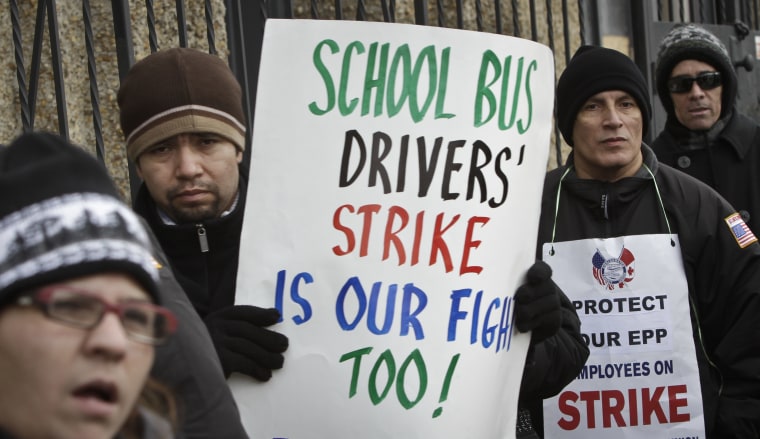For over 150,000 students of New York City schools, the wheels on the bus don’t go round and round any more. In one of the most surprisingly under-reported stories in the county, the workers of Amalgamated Transit Union Local 1181 are beginning their third week on the picket line, and negotiations are not going well.
The walkout, which started on Jan. 16 after the city endangered the job security of 8,800 public school bus drives by opening up bidding for contracts with private companies, has evolved into a battle with no clear end in sight. Capping off a week-long power struggle, The National Labor Relations Board ruled in favor of the legality of the strike Friday, allowing bus workers to continue their walkout. Jeffrey Pollack, attorney for the New York City School Bus Contractors Coalition, told NBC News that he was “disappointed but not surprised” by the ruling and, “will continue to do everything we can to get the buses rolling so we can get New York City’s school children back to school safely." The Bus Contractors already started using replacement drivers to restore 59 of the 113 city routes to service as of Tuesday morning. The following day, the city turned down an offer from the union to have drivers return to work for a two to three month "cooling off period" if the city postponed putting the contracts up for bid.
The city has offered students bus and train passes and refunding taxi receipts since the start of the strike, and in some cases “scab” drivers have begun operating school buses again. These regulative measures have enriched livery cab drivers, but signs indicate that the general public is still on the side of the workers. Staten Island Live, a popular website for residents of the most reliably Republican borough, polled its readers and of the 5,000+ respondents, 55% say Mayor Bloomberg deserves the blame.
The core dispute in the strike is a job security provision known as “Employment Protection Provisions” (EPPs) that guarantee senior drivers will have work even if the city changes contractors. As our fellow msnbc colleague Ned Resinkoff explains, Bloomberg is accusing union workers' argument of safety is merely a pretext, and what they truly want is job protections the city is not legally able to provide, ostensibly referring to a 2011 Appeals Court Case that ruled against EPPs. On the other hand labor leaders and lawyers claim that the ruling only affects the bus services to students in prekindergarten or younger that were under discussion in the case.
A truly forward thinking public servant should take this crisis--the first school bus driver strike in over 30 years--to re-think the way that the city spends its money. For his final budget, Mayor Bloomberg cut overall spending by 1.1%, his 12th set of across-the-board reductions in a row, Reuters reports. When announcing the new budget–which includes reducing the number of teachers in city schools by 1,800--this Tuesday, Bloomberg told reporters, “I’ve got 336 days to work as hard as I can.” Unfortunately the mayor working hard looks involves cutting essential services and supporting labor relations that leave city workers in perpetual precarity.
New York City stands as a symbol of wealth in America and one of the principal motors of the global economy, if the local government cannot afford to pay to have trained professionals drive school busses, there is more to be discussed than bus drivers. The memory of the 15 passengers killed during a collision World Wide Tour Bus the Bronx less than two years ago (not to mention a couple pedestrians hit by a private bus in Manhattan the other night) should remind New Yorkers about the need for competent vehicle operators. When New Yorkers go to the polls this November, they should look for a leader that can come up with creative solutions to pressing problems that don’t throw children, parents, and city workers under the bus.
